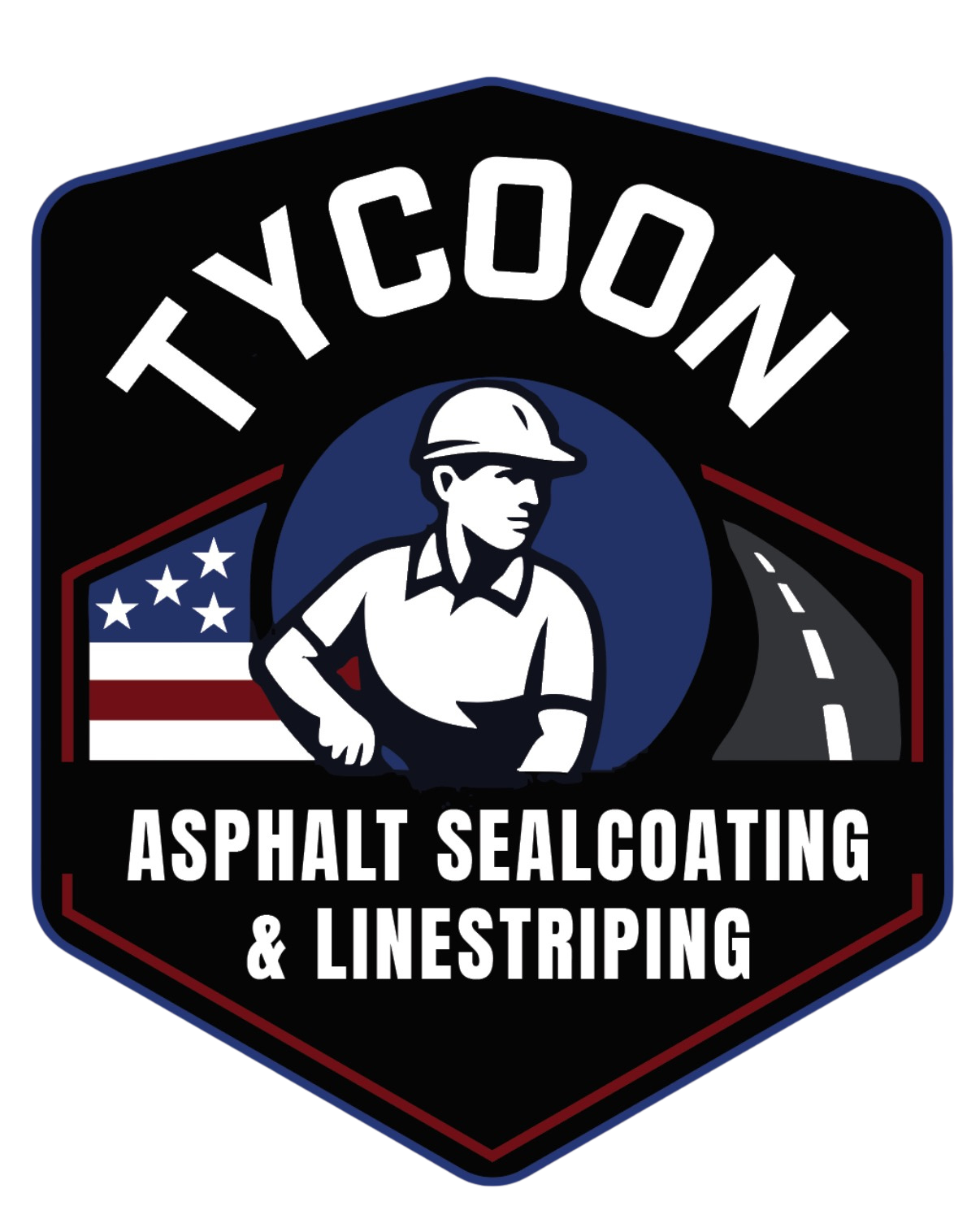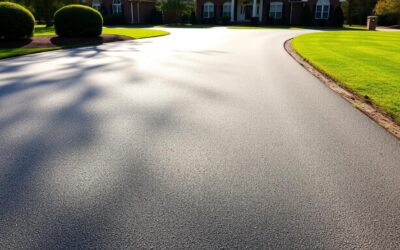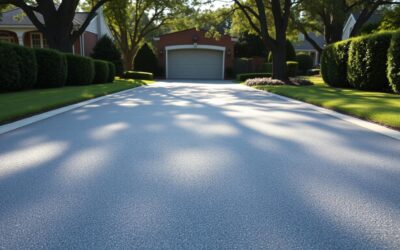We help business and property managers plan asphalt care so pavement looks professional and lasts longer. This introduction explains what sealcoating means and why choosing the right time matters in our area.
When we schedule a parking lot service, we aim for warm, dry stretches so the seal cures correctly. Proper timing reduces oxidation, moisture damage, and UV wear, and it can noticeably extend asphalt life.
Later sections walk through how weather affects curing, which seasons give the best results, what day-of conditions we require, and how we prep the surface. We focus on clear communication and minimal disruption so your business stays open while we protect your pavement.
How Charlotte’s weather impacts asphalt surfaces and sealcoat performance
How asphalt reacts after we apply a sealer depends mostly on temperature, moisture, and sunlight. We check these factors before each job so pavement gets a uniform, long-lasting finish.
Temperature bands that help or hurt curing
We aim for air and pavement temperatures above 50°F, with 60°F–80°F ideal for steady curing and strong adhesion. Below 50°F the product can stay tacky and fail to bond well.
If temps rise above about 85°F the sealer can dry too fast. Flash drying causes streaks and weaker binding to the asphalt.
Humidity, rain, and morning dew: moisture risks to watch
High humidity, passing rain, or morning dew can cause bubbling or uneven coverage. The surface must be fully dry and stay dry for at least 24 hours after application.
We verify there is no standing water nearby and confirm a clear window in the forecast before we start.
Sunlight, UV rays, and oxidation across the year
Direct sun and UV rays accelerate oxidation and make asphalt brittle over time. A well-timed application helps the sealer form a uniform film that resists water and contaminants.
On site we evaluate shade patterns to avoid hot spots that lead to uneven curing and early wear.
Sealcoating Charlotte NC best time: the optimal seasons for durable results
Choosing the right season makes a big difference in how long pavement protection lasts. In our area, pairing warm days with a clear 24-hour window gives the most reliable results for asphalt treatments.
Late spring to early summer: late April through mid-June sweet spot
Late April through mid-June often delivers steady temperatures and fewer storms. We find this window lets coatings cure evenly and reduces callbacks.
Summer advantages: warmer temps, longer daylight, faster drying
Summer brings longer days and warm overnights that speed drying without sacrificing bond strength. We still avoid any rain or heavy fog within 24 hours of application.
Early fall possibilities vs. winter limitations
Early fall can work when nights stay mild and forecasts are dry. Winter, however, brings cool nights, dew, and rain that slow curing and create soft, uneven films.
We monitor short- and medium-range forecasts so we can secure the best time year for your project and protect your investment.
On-the-day conditions we need before we seal your parking lot
Before we start, we verify a few critical factors that decide whether the sealer will cure evenly. These checks help us avoid rework and keep your lot ready for use quickly.
Air and pavement temperatures staying above 50°F
We confirm both ambient and pavement temperatures stay above 50°F, with 60°F–80°F as our target range for steady curing. This prevents cold spots that slow set and hot zones that skin over too fast.
Dry forecasts and a clear 24-hour window after application
We require a dry, clean surface and at least 24 hours with no rain, fog, or heavy dew. Even small amounts of water can mar the film and interrupt curing, so we only proceed when the forecast is clear.
Managing humidity, wind, and direct sun for even curing
On site we evaluate humidity, wind, and sun exposure. We adjust mix and spread rates, stage crews, and control traffic with barricades so the sealer lays down smoothly and dries on schedule.
We keep you updated in real time and reschedule if conditions shift, protecting the quality of the project and minimizing downtime.
Prep that extends pavement life: repairs and surface readiness
A strong, lasting finish starts long before we lay down the new protective layer. Our prep work prevents small issues from turning into costly problems and helps the new layer bond uniformly to the asphalt.
Crack filling and pothole repairs to stop water intrusion
We begin with a careful inspection to find cracks and defects that allow water to reach the base. Filling those cracks and addressing potholes stops water from causing deeper damage to the pavement.
When the base is sound, the sealcoat layer rests on a stable surface and resists delamination. Small repairs ahead of sealing reduce callbacks and extend life under traffic.
Cleaning oil, dirt, and debris for strong sealer adhesion
Next we pressure-clean the lot and treat oil spots so the surface is free of contaminants. Clean areas let the sealcoat bond evenly for a smooth, consistent finish.
We also clear joints, curbs, and drains, spot-prime oil-impacted zones, and adjust material rates to match asphalt porosity. That final dust-free sweep ensures the coating cures evenly and performs as designed.
Planning around your business: scheduling, traffic, and curb appeal
We plan phased work and off-hours schedules so your operations stay open and customers find parking with little disruption. Our approach keeps entrances, loading areas, and key stalls available while crews work in sections.
Phased work and off-hours to keep parking and entrances open
We build a schedule that respects peak periods and uses nights or weekends when possible. This lets us refresh one section at a time so tenants and guests still use most of the parking lot.
We manage traffic with cones, tape, and clear signage so customers and staff navigate safely during work. Our team coordinates with property managers to sequence entrances and loading docks to reduce downtime.
We align application windows with favorable weather and curing conditions so each treated section reopens on plan. After curing, we refresh striping and ADA access to improve safety and curb appeal.
We keep communication open from start to finish, document progress, and leave you a clear record of the service. A crisp, uniform finish helps your property make a strong first impression and supports tenant satisfaction.
Aftercare essentials: curing time, reopening, and maintenance
How you manage reopening and upkeep directly affects the surface’s lifespan. We give clear guidance so your lot recovers cleanly and stays attractive for years.
When traffic can return and how many hours to wait
We recommend keeping vehicles off treated areas for a minimum of 24 hours. Add extra hours when temperatures or humidity are marginal.
Reopening in phases helps the lot return to full use without scuffing or tracking. Phased access also reduces the risk of early damage to the fresh film.
Drainage, cleaning, and routine inspections every few months
Check drainage after the first rain. Standing water shortens the coating’s service life and can lead to premature wear.
Regular sweeping, prompt oil cleanup, and quick attention to hairline cracks stop moisture from reaching the base. We offer post-project check-ins within the first year to spot issues early and recommend touch-ups that extend life.
Ready to protect your lot today and extend its life for years
Keeping your lot in good shape helps customers and extends the life of your asphalt. We schedule work in late spring and early summer when warm, dry days give the sealer the best chance to cure.
We tailor services to your commercial property and include repairs for cracks and select potholes so the surface bonds correctly. A two-year cadence often prevents oxidation and keeps pavement from deteriorating under daily traffic.
We also build a simple maintenance calendar with sweeping and oil cleanup reminders for the next months. Contact us today for a custom estimate and to book during summer or late spring to lock in favorable conditions and boost curb appeal.




0 Comments